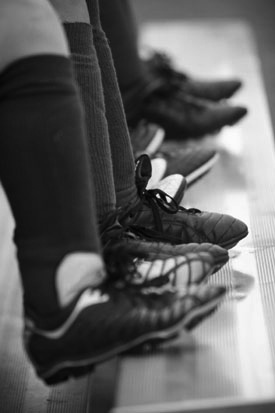 By Veronica Smith and Stephanie Patterson, authors of Getting into the Game: Sports Programs for Kids with Autism.
By Veronica Smith and Stephanie Patterson, authors of Getting into the Game: Sports Programs for Kids with Autism.
Research into the activity patterns of children with ASD indicate that many of these children are not participating in a sufficient level of physical activity to encourage healthy development. But parents have several very real fears and concerns that make them hesitant to enroll their children with ASD in sport.
Let’s consider a few of these concerns and discuss some possible solutions:
1. He’s too sensitive.
In sporting venues, athletes need to adjust to many new sensory experiences. The swimming pool, the skating rink, the soccer/football field, the tennis court, or the martial arts studio (dojang) each present the participant with a unique constellation of sounds, smells, and visual experiences. Children with sensory issues may struggle to adjust to these new environments. The sensitivities may be so distressing for some students that it is difficult for them to benefit from the instruction within the sport lesson. For some students, these sensitivities may lead to inappropriate behaviours that make it challenging for them to learn and that may be disruptive or distracting for others.
Interventions have been developed to target some of these sensory issues. While no one intervention is the magic bullet, some are effective in increasing children’s participation in leisure, play, and social activities. In Getting into the Game we provide descriptions of some of these interventions and describe how they can be adapted to sporting environments. Reflecting on these suggestions and adapting them to suit other circumstances may be useful for children who experience sensory issues that prevent them from participating in sport.
2. She only likes doing one thing.
Some children with ASD have certain enthusiasms or ways of playing that take precedence over all else. They prefer to do only the things that they are interested in and this makes it difficult to introduce new activities.
Introducing new activities and routines may be challenging but it can be done. For most children with ASD, expanding repertoires of play and interests is a goal within their home and school programming. Participating in a sport and recreational activity is a great place to start to work on this goal. However, you need to remember to introduce new activities slowly. Most children with ASD can ease into a new activity if they are given transition cues and visual schedules that help to clarify changes and what is coming up next. In the book we show how some of these strategies can be used to introduce sport activities.
3. We tried it before and it didn’t work.
Sometimes you have to try something more than once. There are many reasons why sports programs may fail children with ASD. Often, there are several things that we can do to prevent problems before they occur, and to prepare yourself, the coach, and your child to be more successful in the sport. With the right supports and the right program we have observed many children with ASD succeed in sports. We share these stories with you in Part 2 of the book, and we hope that you can use them as models to try and find the right program and supports for your child to be successful in sport.
Find out more about the benefits of sports activities for children with ASD, and check out Getting into the Game for a wide range of strategies to help your child get involved.
*This article is adapted from Chapter 2: Choosing a Sport.
Copyright © Jessica Kingsley Publishers 2012.